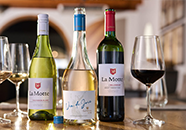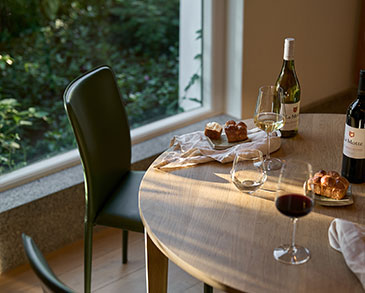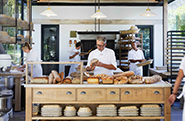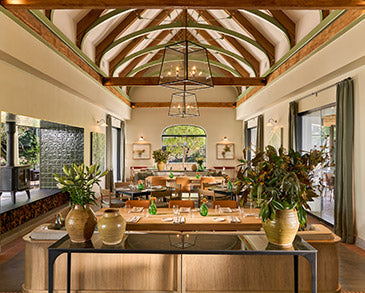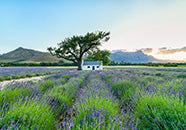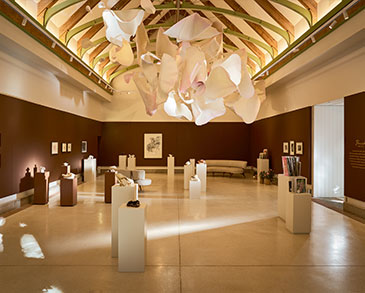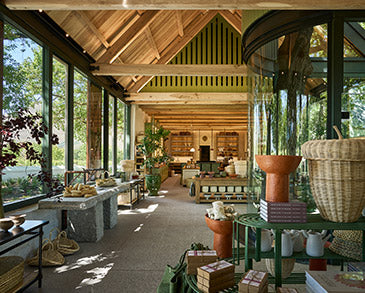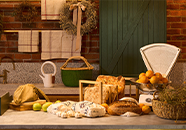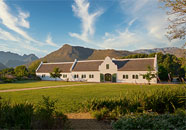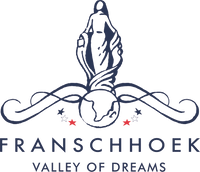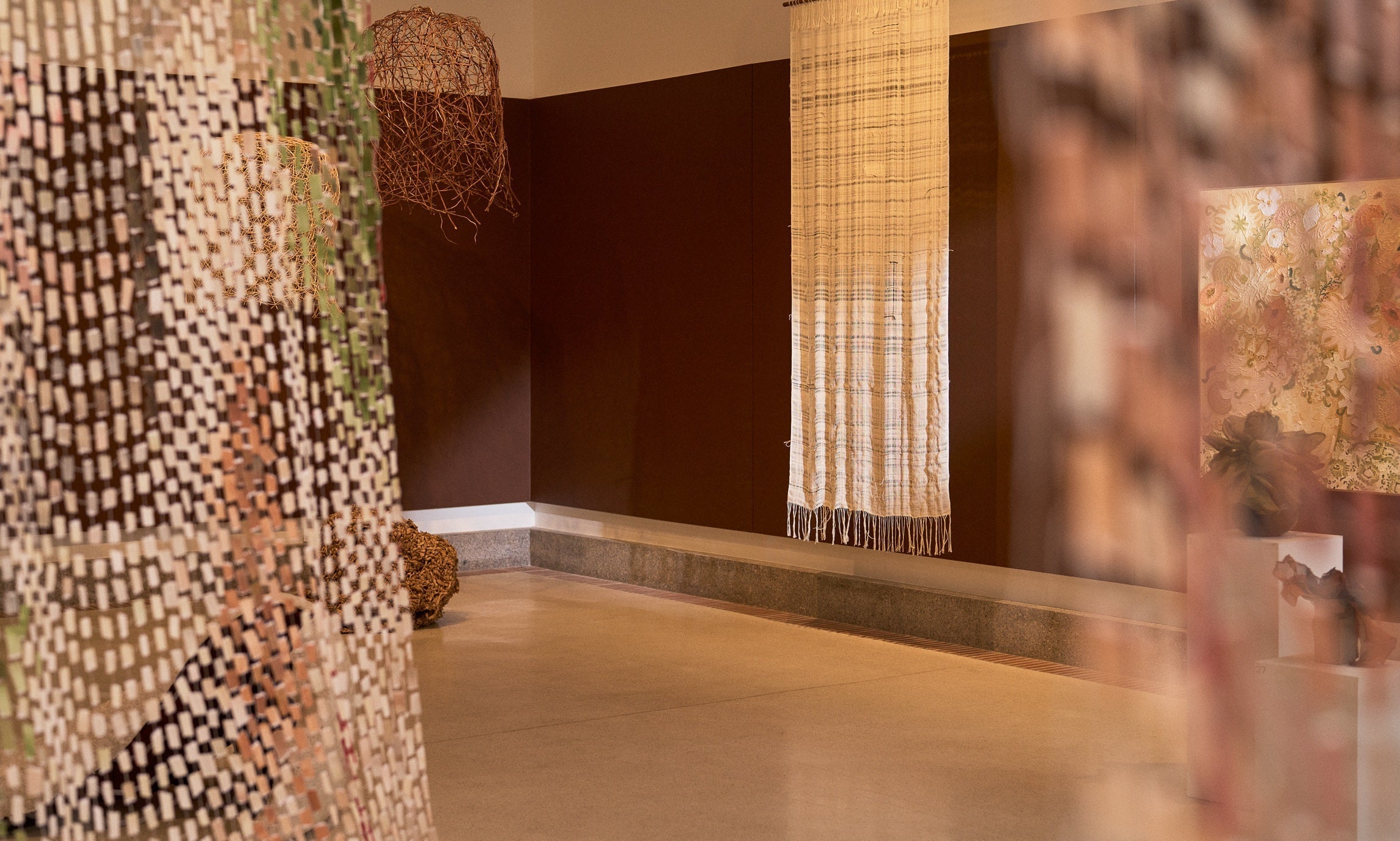
It is that time of year when nature revels in the turn from winter to spring - generously unfolding in textures that wrap you in the warmest welcome as you arrive at La Motte Wine Estate in Franschhoek. Samarie Smith-Meletiou describes how she experiences the textured heritage at La Motte - from vineyard to wall to table.
Arrive before noon and the scene greets you in layers: thin golden slats of sunlight stretching across the mountain slopes, slipping through the open ribs of morning clouds. The vineyards stand bare, like a stretched canvas anticipating its first stroke of spring with budburst. In the garden, the statue of the wine bearer fits the scene with a serene presence - her overflowing cup heralding the abundance of the season ahead. By the time you cross the estate's threshold, it's clear how the tactile wonder of nature becomes a shared inspiration for creatives - explored through ceramics, painting, culinary art, and winemaking for us to enjoy. For South Africans, September is also Heritage Month, its significance celebrated through creative endeavours often shaped by the environment that surrounds us.
Since the moment we are born, our bodies know how to feel - an inherited yearning to engage the senses. Is it not beautiful how we are equipped with a sensitivity so particular it begins shaping our preferences long before we learn the words to explain them? From day one, we start building a sensory vocabulary - our inner library of texture.
Velvety. Chalky. Balmy. Unctuous. Bubbly. Glazed, fibrous, and raw.
We are wired to crave these things: to find comfort in softness, or in its contrasting opposite. To notice the shift in sensation between the coarse weave of a woollen blanket and the satin weight of a cat's fur on your lap. The warmth of the sun on our faces. The lone nightbird, threading a silver lining into the night sky with its song. From soothing warm tea to the bracing sensation of ice-cold water on a scorching day. Texture isn't just aesthetic - it lives in memory. A reminder that we, and everything around us, originate from the same macrocosm.
Visiting La Motte, an interconnectedness with nature finds a foothold in the Farm Shop, Bakery, Spens, L'Ami Brasserie, and the Ateljee where the current exhibition, When Surfaces Speak, curated by Nina Kruger, is a celebration of texture across form and medium. Displayed against an earthy Pantone, Kruger's vision draws from her background in fibre and texture, having completed her master's in Poland. Her work is composed of dried proteas, broken open and felted together with alpaca hair using a dry-felting technique.
"I don't like working alone," she says. "The material becomes my co-creator." Shaped by process, her art creates a dialogue between plant and animal, with the human as observer - an ode to how we see ourselves in our environment and how we move through it.
Kruger calls ceramicist Adele Sherlock a "textural alchemist" - her porcelain forms echoing a marine-like delicacy. They invite a visual caress, where shadows play as much a role as the delicate piping that binds the fragile pieces. The golden thread continues in Leila Walter's delicate, handwoven textiles - rhythmic meditations carried across warp and weft - and in Rita Trafford's Karoo-inspired "softly framed" mohair weaves, juxtaposing airy fibres with the wire fencing that defines these arid landscapes.
"And then there is Karla Nixon," Kruger adds, gesturing toward a waterfall of hand-torn paper blocks. "The gift that keeps on giving."
Each time you look, something new reveals itself - the intricacy, the colours, the layering, the patience - assembled from something as humble as paper, yet displayed with precision.
"Even the time curating it is part of the process. To watch something arrive in a little packet and grow into this grand presence."
The heritage of many of these artists has inspired them to create from their environment and elevate the mundane into high art. Amy Rusch stitches layers of found plastic, while Gina van der Ploeg weaves with coarse invasive plant fibres. Lené Ehlers and Heike Taschner both explore flowers in shifting states and Christine Jacobs uses merino wool from her family farm as a bridge between farming, product, and craft. Sera Holland continues to translate the beauty of the South African landscape while Okracandle redefines candle wax into forms beyond its familiar role.
Wool. Wax. Impasto. Mesh. Fragile, brittle and simply beautiful.
Which brings us to an unequivocal truth: texture alone can elevate something simple, giving it a bold kind of gravitas. It's built through time, repetition, layering, patience, process, and attention - the same virtues that give weaved fabric its soul, a loaf its crust, or a fine wine its poise. At La Motte, this dialogue between hand and material flows naturally from the gallery walls to textures created in the kitchen and cellar.
Because what is texture, if not time made visible?
In South Africa, lighting a fire for a braai is both tradition and craft, and during Heritage Month, this will be a catalyst for many joyful gatherings. At La Motte's L'Ami Brasserie, food over fire has become a permanent institution. This cooking method combines radiant and conductive heat to create a spectrum of temperatures that build the deep flavours we know so well. That first sizzle of fat hitting the coals signals the Maillard Reaction at work, proteins and sugars on the surface of the meat transforming into savoury complexity. Vegetables undergo a similar alchemy. Over flames, their water evaporates without trapping steam, encouraging a magical kind of caramelisation not achievable in an oven. And then there is the smoke from burning wood - in sight and in flavour - the genie of the braai, transforming anything placed on the grid into a flavour dream.
And we all know, a smell can undo you. It can break you open, pouring out nostalgia from a single food memory - the steam of tomato bredie in your mother's kitchen, cumin drifting on the air, catching the light on her cheek as she lifts the lid and breathes it in with closed eyes. Or coming home to the faintest drift of braai smoke - tangled with laughter and the promise of wine poured at a long table.
Chef Stephan Moolman at La Motte's L'Ami Brasserie shares this conviction. For him, texture and temperature are the great alchemists of the kitchen. "We evolve with the seasons. When something goes out of season, you have to be inventive." At the moment, he's preparing a citrus purée and a potpourri from roses. Every plate, he says, must express balance. "It doesn't have to be over the top to impress. Texture is not just something you can touch - temperature, hot-cold, plays a huge role in exciting the palate."
Open-fire cooking is one of his tactile signatures. "We use Kameeldoring wood and light the first fire at 11:00. A guest from Namibia walked in and recognised the wood by its smell - it took him straight back home." That's the power of texture and scent intertwined. We reserve the evening coals for "aspatat" - sweet potatoes left in the embers overnight. Most vegetables are cooked over flames; even the butter for the mashed potatoes is smoked. "Fire is not a cooking method - it's an ingredient."
As with the artists in When Surfaces Speak, there's a reverence for the humble - beetroot, for example - transformed through acid, fire, and time. Beetroot fired and caramelised. Baby beets sliced thin with a mandoline, pickled, paired with herbed cheese, lemon zest, olive oil, and Maldon salt. The unsung cuts of meat that yield crisp and flavourful surprises. "We're all seeking simplicity," Stephan says. "It's like we have entered a period of sensory awakening."
In the wine cellar, the understanding of texture reaches its most delicate yet unassuming form. Texture is often mistaken for something technical - the moment "phenolic compounds" enter the conversation, the joy of a tasting can fade as the science overshadows the sensation. Yet, quietly behind the scenes, winemaker Edmund Terblanche keeps his finger on the pulse of nature's whims while guiding the development of wines in barrel. Every stage contributes to those texture-forming elements that give wine its sensory character.
But the work begins long before the cellar. Texture is born in the vineyard, shaped by the raw design of soil, wind, and rain that carries flavour precursors unique to its site. The winemaker becomes a translator, coaxing what the vineyard offers into something the palate can feel. "Sandy soils at La Motte yield wines with a creamier mouthfeel; granite lends structure; shale imparts mineral clarity," shared Terblanche.
For him, texture goes beyond the glass. "A wine's texture communicates where it comes from - and whether it was treated with the respect it deserves."
"You already have a framework of expectation when you look at a wine," he explains. "If it's dark and intense, you expect something ripe, smooth, maybe velvety on your palate. That's texture speaking before you've even tasted it."
Every wine brings a certain weight to your palate - a presence that must be matched by the food you enjoy with it. This density is woven from alcohol, sugar, tannin (especially in reds), acidity, and texture. Glycerol, another form of alcohol, contributes to that viscous, almost silky sensation in the mouth. All these elements need to be in harmony, racing together to the flavour finishing line. While both tannin and acidity can form the armature of a wine, their taut and puckering sensations must find equilibrium with the fruit. The winemaker, as an artist, can intervene - softening acidity through malolactic fermentation for a creamier feel, or choosing fermentation and maturation vessels such as French oak or clay amphora to soften tannins through slow micro-oxidation. It is this textural foundation that will elevate an array of aromas to give each wine it typicity. We are each charged with textural memory; the wine stirs it.
Silk. Sinewy. Chalky. And then the more colloquial textures - like biting into a green apple, licking a river stone, or the burst of berries between your teeth - that make it downright delicious.
Making wine is an act of drawing you in - from sweet to savoury, creamy to chalky - a seamless interplay of fruit, acid, alcohol, and tannin ensuring the wine leaves its mark. The chemistry may be intricate - alcohol contributing glycerol, oak adding grip, lees stirring/ageing building creaminess - but as Terblanche notes, "It's not just about technique. You need enough components in the cellar to play with. That's the luxury. Texture is built on choice."
For a wine to linger and leave you with that memorable feeling - it must have weight, tension, and purity. It must be able to stand beside food and keep its integrity. Otherwise, you risk the clash: protein against tannin, acid against acid, dismantling what time has so carefully built, Terblanche adds about food and wine pairing. This is where the chef and winemaker meet as sensory architects, working with texture as their common language to create a layered experience.
Learning the language of wine in texture open a whole new vista of experience, that feeling a pillowy silkiness on your palate will announce Chardonnay, a thread of salt evoke Sauvignon Blanc and a velvet veil reaching into every crevice of your mouth, lifting the fruit onto a pedestal spells Shiraz and make you crave crispy lamb riblets over the fire.
There is the fire before a meal, the one cooking the food, and the one rekindled for conversation afterwards. Smoke rising into the night. Conversations catching fire as corks ease from bottles. Those tangible memories make us feel alive, don't they? Whether in a weaving technique, a slow braise, or leaving wine on the lees for another year - time draws out the detail. The very surfaces that speak.
Join the La Motte team for a textural experience of note.
The exhibition entitled When Surfaces Speak runs in the La Motte Ateljee until 5 October.
Don't miss an evening of art, wine and food inspired by texture on Friday, 26 September. Click here to read more and book.

